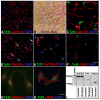Satellite cells, connective tissue fibroblasts and their interactions are crucial for muscle regeneration
- PMID: 21828091
- PMCID: PMC3152921
- DOI: 10.1242/dev.064162
Satellite cells, connective tissue fibroblasts and their interactions are crucial for muscle regeneration
Abstract
Muscle regeneration requires the coordinated interaction of multiple cell types. Satellite cells have been implicated as the primary stem cell responsible for regenerating muscle, yet the necessity of these cells for regeneration has not been tested. Connective tissue fibroblasts also are likely to play a role in regeneration, as connective tissue fibrosis is a hallmark of regenerating muscle. However, the lack of molecular markers for these fibroblasts has precluded an investigation of their role. Using Tcf4, a newly identified fibroblast marker, and Pax7, a satellite cell marker, we found that after injury satellite cells and fibroblasts rapidly proliferate in close proximity to one another. To test the role of satellite cells and fibroblasts in muscle regeneration in vivo, we created Pax7(CreERT2) and Tcf4(CreERT2) mice and crossed these to R26R(DTA) mice to genetically ablate satellite cells and fibroblasts. Ablation of satellite cells resulted in a complete loss of regenerated muscle, as well as misregulation of fibroblasts and a dramatic increase in connective tissue. Ablation of fibroblasts altered the dynamics of satellite cells, leading to premature satellite cell differentiation, depletion of the early pool of satellite cells, and smaller regenerated myofibers. Thus, we provide direct, genetic evidence that satellite cells are required for muscle regeneration and also identify resident fibroblasts as a novel and vital component of the niche regulating satellite cell expansion during regeneration. Furthermore, we demonstrate that reciprocal interactions between fibroblasts and satellite cells contribute significantly to efficient, effective muscle regeneration.
Figures







References
-
- Alexakis C., Partridge T., Bou-Gharios G. (2007). Implication of the satellite cell in dystrophic muscle fibrosis: a self-perpetuating mechanism of collagen overproduction. Am. J. Physiol. Cell Physiol. 293, C661-C669 - PubMed
-
- Bailey A. J., Shellswell G. B., Duance V. C. (1979). Identification and change of collagen types in differentiating myoblasts and developing chick muscle. Nature 278, 67-69 - PubMed
-
- Caldwell C. J., Mattey D. L., Weller R. O. (1990). Role of the basement membrane in the regeneration of skeletal muscle. Neuropathol. Appl. Neurobiol. 16, 225-238 - PubMed
Publication types
MeSH terms
Substances
Grants and funding
LinkOut - more resources
Full Text Sources
Other Literature Sources
Molecular Biology Databases

